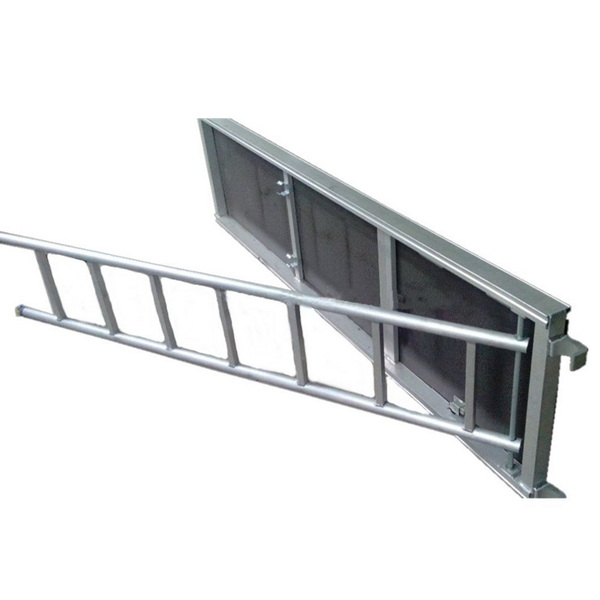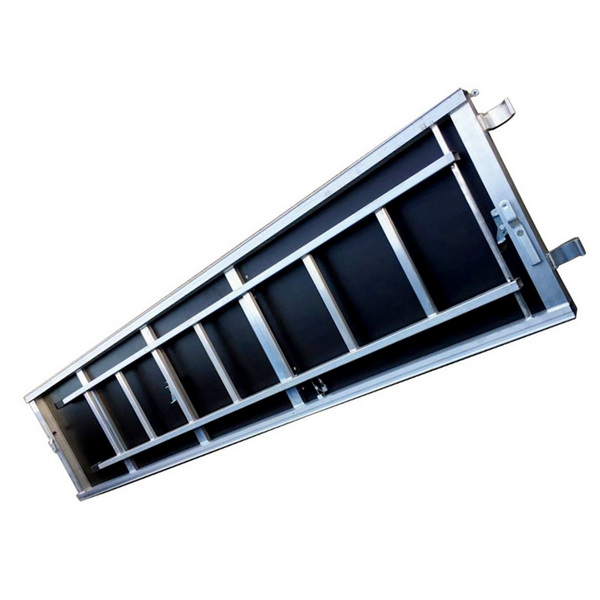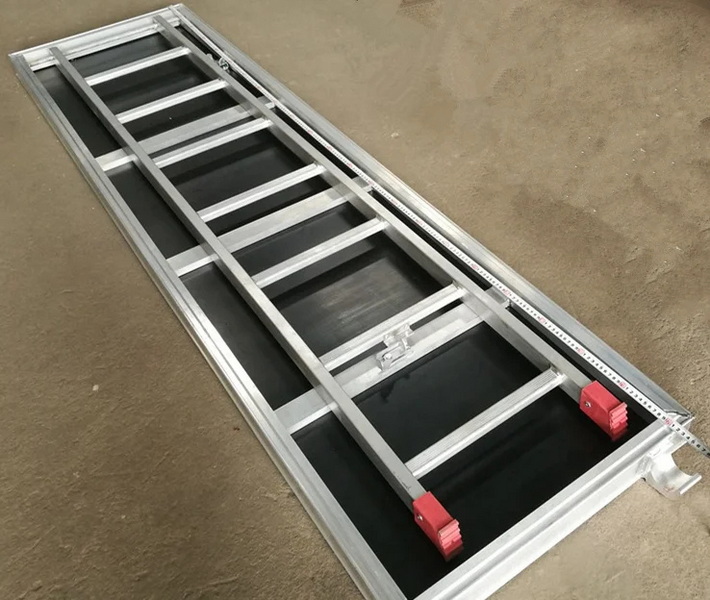Content Menu
● What Is an Aluminum Ladder Plank?
● Can You Use an Aluminum Ladder Plank Between Two Ladders?
● Step-by-Step: Setting Up an Aluminum Ladder Plank Between Two Ladders
>> 1. Choose the Right Equipment
>> 2. Inspect All Equipment
>> 3. Set Up the Ladders
>> 4. Install Ladder Jacks or Trestle Brackets
>> 5. Position and Secure the Aluminum Ladder Plank
>> 6. Check Stability
>> 7. Add Safety Features
● Safety Standards and Regulations
>> OSHA and ANSI Guidelines
>> General Ladder and Plank Safety
● Advantages of Using an Aluminum Ladder Plank
● Real-World Applications
>> Painting and Siding
>> Window and Gutter Work
>> Interior Projects
>> Event Setup and Temporary Staging
>> Maintenance and Repairs
● Maintenance and Inspection
● Common Mistakes to Avoid
● Comparison: Aluminum Ladder Plank vs. Wood Plank
● Best Practices for Using an Aluminum Ladder Plank
● Conclusion
● FAQ
>> 1. Is it safe to use an aluminum ladder plank between two ladders?
>> 2. How much weight can an aluminum ladder plank support?
>> 3. Can I use an aluminum ladder plank without ladder jacks?
>> 4. What is the maximum span for an aluminum ladder plank between ladders?
>> 5. What safety precautions should I take when using an aluminum ladder plank?
Using an aluminum ladder plank between two ladders is a common solution for creating a temporary elevated work platform, especially for painting, siding, window replacement, and other exterior or interior projects. However, safety, proper setup, and adherence to regulations are paramount. This comprehensive guide explores how to use an aluminum ladder plank between two ladders, the best practices, safety standards, and real-world applications.

What Is an Aluminum Ladder Plank?
An aluminum ladder plank is a lightweight, durable, and often telescoping platform made from aircraft-grade aluminum. It is designed to span between two support points—usually ladders, ladder jacks, or trestles—to create a stable surface for standing, walking, or staging tools and materials. These planks are engineered for both professional and DIY use, offering significant advantages over traditional wooden boards.
Key Features:
- Material: Aircraft-grade aluminum for strength and corrosion resistance
- Adjustable Length: Many models telescope from 6–9 ft, 8–13 ft, or 9–15 ft
- Width: Typically 12–14 inches for comfortable standing
- Load Capacity: Ranges from 250 lbs (1-person) to 500 lbs (2-person)
- Anti-Slip Surface: Grooved or textured for safety
- Locking Mechanisms: Secure hooks or detents to prevent accidental movement
- OSHA/ANSI Compliance: Most reputable planks meet or exceed safety standards
Can You Use an Aluminum Ladder Plank Between Two Ladders?
Yes, you can use an aluminum ladder plank between two ladders, but only when you follow strict safety guidelines and use the correct accessories. The safest and most compliant way is to use ladder jacks or trestle brackets specifically designed for this purpose.
How It Works
1. Ladder Jacks or Trestle Brackets: Attach these to the ladders to create stable supports for the plank.
2. Plank Placement: Rest the aluminum ladder plank securely on the jacks/brackets, ensuring it is locked in place.
3. Span: Do not exceed the maximum recommended span (usually 8 feet for ladder jack scaffolds).
4. Load: Never exceed the plank's rated capacity or the ladders' duty rating.
Step-by-Step: Setting Up an Aluminum Ladder Plank Between Two Ladders
1. Choose the Right Equipment
- Aluminum ladder plank rated for your intended load and span
- Two heavy-duty ladders (Type IA or IAA recommended)
- Ladder jacks or trestle brackets compatible with your ladders and plank
2. Inspect All Equipment
- Ensure ladders are in good condition, stable, and free of oil or grease
- Check the plank for dents, cracks, or worn locking mechanisms
- Inspect ladder jacks/brackets for wear or damage
3. Set Up the Ladders
- Place ladders on a stable, level surface
- Space ladders at the correct distance for your plank length (usually 6–8 feet apart for an 8–13 ft plank)
- Ensure ladders are locked open and secured against movement
4. Install Ladder Jacks or Trestle Brackets
- Attach ladder jacks/brackets to the ladders at the same rung height
- Secure according to manufacturer instructions
5. Position and Secure the Aluminum Ladder Plank
- Place the plank on the jacks/brackets so both ends are fully supported
- Engage locking hooks or detents to prevent sliding
- Ensure at least 6 inches of plank extends beyond each support, but not more than 18 inches
6. Check Stability
- Gently apply pressure to test for movement
- Ensure the platform is level and secure before use
7. Add Safety Features
- If working at height, use guardrails or fall protection as required by OSHA
- Never use the plank above 20 feet from the ground on ladder jacks
Safety Standards and Regulations
OSHA and ANSI Guidelines
- Platform Width: Minimum 12 inches wide
- Maximum Span: 8 feet between supports for ladder jack scaffolds
- Load Rating: Do not exceed 25 lbs/ft⊃2; for ladder jack scaffolds
- Height Limit: Maximum working height is 20 feet above the ground
- Number of Workers: No more than two workers per platform
- Ladder Requirements: Ladders must meet OSHA Subpart X standards and be of sufficient duty rating
- Plank Overlap: Plank should overlap supports by at least 6 inches, or be cleated/restrained at both ends
General Ladder and Plank Safety
- Maintain three points of contact when climbing
- Never use ladders or planks near electrical lines—aluminum conducts electricity
- Do not use if ladders or planks are damaged or unstable
- Never bridge two platforms together with a plank

Advantages of Using an Aluminum Ladder Plank
- Lightweight and Easy to Transport: Aluminum planks are much lighter than wood, making setup and takedown easier
- Corrosion Resistant: Aluminum will not rust, even with outdoor use
- High Strength-to-Weight Ratio: Supports significant loads relative to its weight
- Adjustable Length: Telescoping models allow for flexibility on different jobsites
- Long Lifespan: Durable and resistant to damage from weather or chemicals
- Slip-Resistant Surface: Grooved or textured for better traction
Real-World Applications
Painting and Siding
Using an aluminum ladder plank between two ladders allows painters and siding installers to cover large horizontal areas without constantly moving ladders.
Window and Gutter Work
Provides a stable platform for window installation, cleaning, or gutter repair, especially on multi-story homes.
Interior Projects
Great for drywall, crown molding, or ceiling repairs where a scaffold is impractical.
Event Setup and Temporary Staging
For event professionals, an aluminum ladder plank can be used to quickly create temporary platforms for lighting, sound equipment, or decorations. Its portability and ease of setup make it a favorite for short-term needs.
Maintenance and Repairs
Whether it's replacing exterior trim, cleaning hard-to-reach spots, or performing routine building maintenance, the aluminum ladder plank offers a stable, reliable solution.
Maintenance and Inspection
- Clean regularly: Remove dirt, paint, and debris from the plank surface
- Inspect before each use: Look for cracks, dents, loose hooks, or worn locking mechanisms
- Store properly: Keep planks in a dry, covered area to prevent unnecessary wear
- Replace damaged parts: Many planks have replaceable hooks and locking mechanisms
- Lubricate moving parts: For telescoping planks, occasionally lubricate the sliding mechanism with a dry lubricant to ensure smooth operation and prevent sticking.
- Check anti-slip surface: Ensure the grooved or textured surface remains intact and free from excessive wear or buildup.
Common Mistakes to Avoid
- Using the wrong ladders: Only use ladders rated for the expected load and compatible with ladder jacks
- Overextending the plank: Never exceed the manufacturer's maximum span or load rating
- Skipping ladder jacks: Do not rest the plank directly on ladder rungs; always use proper jacks or brackets
- Ignoring height limits: Never use ladder jack scaffolding above 20 feet
- Neglecting fall protection: Use guardrails or personal fall arrest systems when required
- Improper storage: Leaving the plank exposed to harsh weather or chemicals can reduce its lifespan and compromise safety.
Comparison: Aluminum Ladder Plank vs. Wood Plank
Feature | Aluminum Ladder Plank | Wood Plank |
Weight | Light | Heavy |
Strength | High | Moderate |
Lifespan | 10+ years | 2–5 years |
Maintenance | Low | High |
Slip Resistance | High (grooved) | Moderate |
Corrosion Resistance | Excellent | Poor |
Adjustability | Telescoping models | Fixed length |
Cost | Higher upfront | Lower upfront |
Best Practices for Using an Aluminum Ladder Plank
- Always follow manufacturer's instructions for both the plank and ladders.
- Set up on a level, stable surface to avoid tipping or shifting.
- Never use a damaged plank or ladder. Replace any equipment that shows signs of wear or damage.
- Do not use in adverse weather such as high winds, rain, or icy conditions.
- Wear appropriate footwear with non-slip soles.
- Limit the number of people on the plank to its rated capacity.
- Secure tools and materials to prevent them from falling off the platform.
Conclusion
An aluminum ladder plank can be safely and effectively used between two ladders when set up with proper ladder jacks or trestle brackets, and when all safety guidelines and regulations are followed. These planks offer lightweight strength, durability, and flexibility for a wide range of elevated tasks. However, never compromise on safety: always inspect your equipment, use the correct accessories, and adhere to OSHA and manufacturer recommendations. With the right setup and precautions, an aluminum ladder plank is an invaluable tool for both professionals and DIYers tackling jobs at height.

FAQ
1. Is it safe to use an aluminum ladder plank between two ladders?
Yes, if you use ladder jacks or trestle brackets, follow all safety guidelines, and do not exceed the plank's span or load rating. Always inspect equipment before use and never use above 20 feet on ladder jacks.
2. How much weight can an aluminum ladder plank support?
Most aluminum ladder planks are rated for 250–500 lbs, depending on width and model. Always check the manufacturer's specifications and do not exceed the stated capacity.
3. Can I use an aluminum ladder plank without ladder jacks?
No. The plank should never rest directly on ladder rungs. Always use ladder jacks or trestle brackets to create a stable and secure platform.
4. What is the maximum span for an aluminum ladder plank between ladders?
For ladder jack scaffolds, the maximum recommended span is 8 feet. Do not exceed this, even if the plank is longer or telescoping.
5. What safety precautions should I take when using an aluminum ladder plank?
- Inspect all equipment before use
- Use only with compatible ladders and jacks
- Never use above 20 feet on ladder jacks
- Use fall protection if required
- Never use near electrical lines (aluminum conducts electricity)
- Do not overload or overextend the plank






















